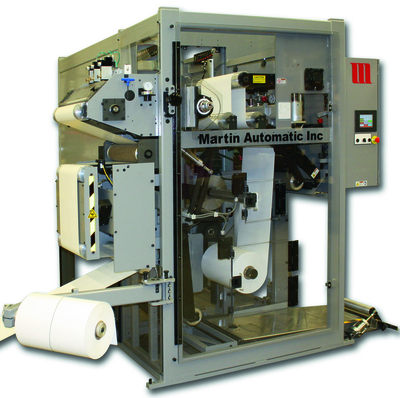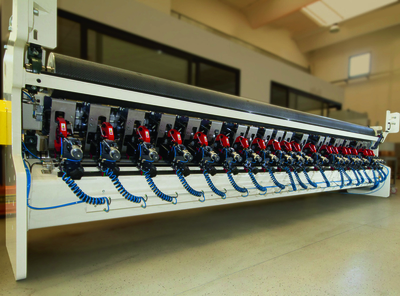Espo has developed this large model for a papermill in South America
Some finishing equipment come with sophisticated inspection and fault finding modules, while others perform a simple but vital function, namely to slit and rewind. Whatever is the right solution for the job in question, the market is brimming with machinery. Here are some of the latest products available. By Neel Madsen.
Winding and unwinding, slitting and rewinding, inspecting and rejecting, die-cutting and embossing, there are many processes surrounding the actual printing.
Handling the printed rolls of labels or packaging requires precision equipment. Whether the slitting and rewinding is done inline or off line on a separate piece of machinery, the process is still the same and the end product should be faultless, tightly wound rolls of products ready for the customer to use.
Versatility
‘In today’s world, reducing wastage at an early stage is paramount, and with the value of raw materials being between 60% and 80% of sales, keeping scrap to a minimum must be essential for all converters,’ said Ashe Converting Equipment’s Matthew Godbold. With this in mind, the company has expanded its Sapphire range of duplex slitter rewinders to incorporate a model called the S²R.
The new machine incorporates a driven unwind with dancer control feedback for high speed operation and accurate tension control, and will handle reels up to 1 metre in diameter. If required, a system on the rewind easily converts the bottom shaft from differential winding to a lift out lock bar arrangement.
The function of the machine is to inspect and rewind cut out damaged material, as well as defective print or other faults, and with its unique versatile rewind system, it can even rewind printed product so that the print is the correct way around for the next operation. If on inspection, there is a missed flag or a splice, it can be reversed back to the unwind, wastage taken off and then continued to the rewind.
By inspecting prior to laminating and coating, not only are there savings in running time to be had, but it also ensures that extra waste is not incurred when two or three substrates are combined. Furthermore, the versatility of the machine means that changing it back to a duplex slitter rewinder can be done in a matter of minutes.
When rewinding, the bottom shaft is lifted out. Normal off loading is by overhead crane, but reel lifting is an option and with the Sapphire’s latest shaftless unwind stand with floor pickup, electric operation loading and unloading of reels is effortless.
Many different options of inspection can be added to the machine, from very simple strobes or back lit inspection areas, to full camera systems, mapping faults from inspection on presses can also be incorporated.
The machines are offered from a base 1.1 metre width up to 2 metre width, with all the special features available on the Sapphire range of machinery including Ashe’s fully automatic tension control system. Operation of the machine is as easy as the S², with full colour touch screen incorporating full operation parameters, job storage system, maintenance programmes and fault diagnostic.
Mr Godbold concluded, ‘Not only will the machine save on scrap, it will also speed up the process because customers can be confident that once the material has been inspected on the S²R, they will be able to increase the process speeds for coating, laminating, slitting and other secondary processes.’
Increase throughput
Located in Lewiston, in California, Converting Equipment International (CEI) manufactures equipment with multi substrates in mind. ‘CEI’s customers are just more profitable,’ stated CEO Simon Gross. ‘From the day you open the crate and install your new CEI machine, you will find your daily throughput increase 2 to 5 times. This is done in a multitude of ways starting from the ground up.’
The demands on rewinders are getting more challenging than ever with new types of materials being introduced and different die-cut shapes becoming the norm. Mr Gross said, ‘These kinds of challenges are where the CEI rewinders really shine. Using the latest technology with servo motors and control, CEI machines are able to run all kinds of demanding materials with ease. With servo motors, taper tensions are standard, making roll profiles and tensions repeatable roll after roll. Another popular option to add is slip differential winding.’
Servos can be changed from torque to position mode at the simple flick of a switch. This in tune with the servos offers significant benefits. Mr Gross said, ‘Have you ever been slitting multiple lanes and one lane gets tighter and tighter while the other lane(s) get looser and looser? With CEI’s differential technology, this issue is now completely eliminated.’
 This Laem System machine is dedicated to APET materials
This Laem System machine is dedicated to APET materials
The company has also completely redesigned the cutting area of the machines. This allows faster set ups and creates less waste with set up usually completed within 3 to 10 feet. Jobs 21+ lanes across that traditionally took 20 plus minutes to set up, now take minutes and with CEI’s quick change knives, it can turn this into seconds, explained Mr Gross. The shear knives allow cuts of just ½ inch to be done with ease. CEI’s razor and crush slitter also allow for a quick set up.
With the high speed and greater throughput, the company has also improved inspection and offers various ways to make the machine run effortlessly while catching defects. From the standard LED strobe light, to ensure the refresh rates happen even with the smallest of labels, to flag and splice detection as well as missing label detection, which uses a camera to look at pattern recognition instead of the traditional sensors. For smaller defects, CEI has partnered with vision inspection companies to ensure no printed, die cut, or other defects get through. On recent installations, CEI has installed a couple of AVT Helios systems that have captured and placed the defects on the editing splice table from CEI’s top speed of 1800 fpm. ‘These types of partnerships are key which ensure efficiency, quality, and the guarantee of perfect product going to the converters customers,’ said Amir Dekel, president of AVT.
Mr Gross concluded, ‘Standard machines are very inclusive and offer a nice machine to run most of your standard products. From there, the machines are field upgradable which can include all of CEI’s options. This allows your machine to grow with your company without needing to buy more machines to accommodate.’
Refreshed range
Among its roll change automation equipment, Martin Automatic offers several lines of automatic transfer rewinders for continuous production in the label, flexible packaging and folding carton markets.
The newest model in the LRD line of rewinders for paper, film, label stock and light paperboard has expanded diagnostics, and a new touchscreen control that includes recipe functions, so that operators can store and recall the winding parameters of repeat jobs quickly and easily. The optional inline slitter package is now enhanced to offer lateral adjustment of the slitter and anvil roller assembly for quicker set up, fine-tuning and changeover between jobs. The LRD offloads finished rolls automatically via one of several standard doffing ramp designs, without the need of a cart, or with an articulating arm that delivers through the side of the unit.
The STR is a compact two-spindle automatic transfer rewinder for film, paper and label stock, and is available with a servo drive option. The servo model delivers increased capabilities for specialised narrow web applications requiring very low winding tensions and expanded taper tension control.
The LRH delivers non-stop rewinding and automatic roll discharge for mid-width presses running paper, film and paperboard. Markets include flexible packaging, folding carton, lottery printing and disposable cups. LRH versions include an 850 mm (33 inch) wide multi-substrate model for paper, film and paperboard and an 1170 mm (46 inch) wide model for multi-ribbon paperboard winding.
The comapny also produces non-stop rewinders for wider widths and speeds up to 914 m/min, including the shafted RMAP and shaftless TR models, as well as an extensive line of automatic splicing unwinds, web transport and tension control systems.
A new module
A new, large slitting module, specifically designed for a papermill in South America,has been unveiled by the Italian specialist, Espo srl. Represented in the UK by Jarshire Ltd, Espo offers advanced cutting technology products for complete inline integration with rewinders, slitter rewinders, sheeters and cutting machines.
Developed from the tried and tested Genius system the new module comprises unique safety features, quick setting of cant angle, depth of cut and new developments in blades to increase blade life.
Quick replacement of blades and bottom knives means that downtime and setting times are reduced. Models are available as manual or automatic, and are fully customisable.

Martin Automatic’s LRD rewinder
Bespoke solution
Italian Laem System reports an increase in sales in the European market. Its most successful model is the turret slitter rewinder, which offer the highest productivity and the downtimes are drastically reduced. The company has also installed a number of bespoke machines in answer to the market demands of more specialisation, where high quality is required.
One of these bespoke machines is a special centre surface slitter rewinder installed at a company in Europe. This particular machine is dedicated to APET (Amorphous Polyethylene Terephthalate) otherwise known as polyester, and can process materials at thicknesses up to 800 micron.
The model features a free-standing shaftless unwinder, picking the parent roll from the ground and capable of handling 3 and 6 inch cores. The unwinder is connected to the machine via an overhead web path and the tension control is handled by a vertical dancing roller for extreme precision.
To handle the thickness of the material, a large diameter driven draw roller with nip roller has been designed to ensure perfect tension isolation between the unwind and the rewind section. The slitting method is tangent or semi-wrapped with Dienes circular knives and counter-knives, with assisted positioning on a digital screen. The centre surface winding is done on four double-arm rewinding stations and adjustable contact pressure on the auxiliary draw rollers (double central drum system).
During the winding procedure, the rewinding stations move backwards on an independent linear tracking system for each winding station, a feature which keeps the point of contact during rewinding constant and ensures that the unloading of the reels is always in the same position regardless of their size. This offers great advantages in terms of quality and easy handling.
The machine is driven by Siemens motors and features a 12 inch touch screen interface. The company offers remote assistance for electronic trouble shooting online and has an after sales office dedicated to supporting its customers in real time as needed.






